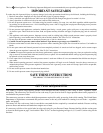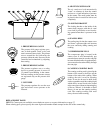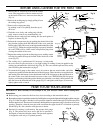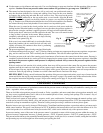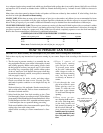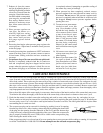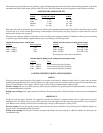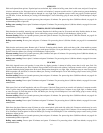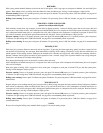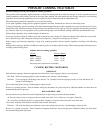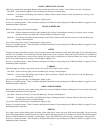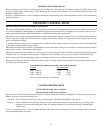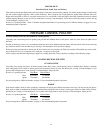
5
Use the canner on a level burner and range only. Use on a tilted burner or range may interfere with the operation of the pressure
regulator. Caution: Do not use pressure canner on an outdoor LP gas burner or gas range over 12,000 BTU’s.
The canner has been designed so the cover will go on in only one position and rotate in
only the directions indicated for closing and opening. Press down on the cover handles
to compress the sealing ring and make the cover easier to close. The cover has the words
CLOSE V OPEN embossed on the top surface near a cover handle. Align the V mark
on the cover with the
V
mark on the body handle for proper cover and body alignment
(Fig. J). Turn the cover in the direction indicated to close (clockwise) until the cover handles
are centered directly above body handles. Do not rotate cover beyond this point.
When the cover is rotated to the closed position, the air vent/cover lock passes under the
locking bracket. When the handles are aligned, one over the other, the pressure regulator is
placed on the vent pipe, and heat is applied, pressure will begin to build within the canner.
At this point, the air vent/cover lock lifts and locks the unit. The cover will remain locked
as long as there is pressure in the canner. When pressure is
completely reduced, the air vent/cover lock drops allowing
the canner to be opened (Fig. K).
If the cover is not rotated sufficiently (cover handles directly
above body handles), the air vent/cover lock will only raise
slightly and steam will continue to flow from it, preventing
pressure from building.
The pressure regulator is placed on the vent pipe following the
10-minute exhaust period (see page 7, step 7). During canning, moisture may appear near the pressure regulator, overpressure
plug, and air vent/cover lock. This is normally due to condensation. This does not affect operation of the canner.
To reduce pressure at the end of the canning period, turn burner off and remove the canner from the heat source. Pressure is
completely reduced when the air vent/cover lock has dropped and no steam escapes when the pressure regulator is tilted. Do
not remove the pressure regulator until pressure is completely reduced. Always remove the pressure regulator before
opening canner.
If the air vent/cover lock remains in its raised position, there may still be pressure in the canner. Do not remove the pressure
regulator until the air vent/cover lock drops and no steam escapes when the pressure regulator is tilted. The cover should not
be forced open. You may tap the air vent/cover lock lightly with a spoon. If pressure is present, steam will escape and the air
vent/cover lock will pop back up. Continue to cool the canner until the air vent/cover lock drops.
HELPFUL HINT: To help yourself understand the operation of the pressure canner and cooker, pour 4 cups of water into the
canner and follow the step-by-step instructions beginning with step 5 on page 6. For actual usage of the canner/cooker, follow
the complete instructions beginning on page 6 for pressure canning and on page 21 for pressure cooking.
PRessuRe CanninG
The United States Department of Agriculture recommends the pressure canner as being the only safe method for canning low acid
foods—vegetables, meats, and poultry.
There are invisible microrganisms present all around us. Fruits, vegetables, and meat contain these microrganisms naturally, and
yet, they are not a problem unless food is left to sit for extended periods of time, causing food spoilage. This is nature’s way of
telling us when food is no longer fit to eat.
There are four basic agents of food spoilage—enzymes, mold, yeast, and bacteria. Canning interrupts the natural spoilage cycle
so food can be preserved safely. Molds, yeast, and enzymes are destroyed at temperatures below 212°F, the temperature at which
water boils (except in mountainous regions). Therefore, boiling water processing is sufficient to destroy those agents.
Bacteria, however are not as easily destroyed. The bacteria, Clostridium botulinum produces a spore that makes a poisonous toxin
which causes botulism. This spore is not destroyed at 212°F. In addition, the bacteria thrive on low acids in the absence of air. For
a safe food product, low acid foods need to be processed at 240°, which can be achieved only with a pressure canner.
In pressure canning, some of the water in the pressure canner is converted to steam, which creates pressure within the canner. As
pressure increases, temperature increases, 5 pounds pressure—228°F, 10 pounds pressure—240°F, 15 pounds pressure—250°F.
This pressurized heat destroys the potentially harmful bacterial spores. As the jars cool, a vacuum is formed, sealing the food within
and preventing any new microorganisms from entering and spoiling the food.
Note: Cover is shown in open
position. Rotate clockwise
to close.
Cover
Handle
Body Handle
Fig. J
Air Vent/Cover Lock
in DOWN Position.
No Pressure in Unit.
Air Vent/Cover
Lock in UP Position.
Pressure in Unit.
LOCKED
UNLOCKED
Fig. K




